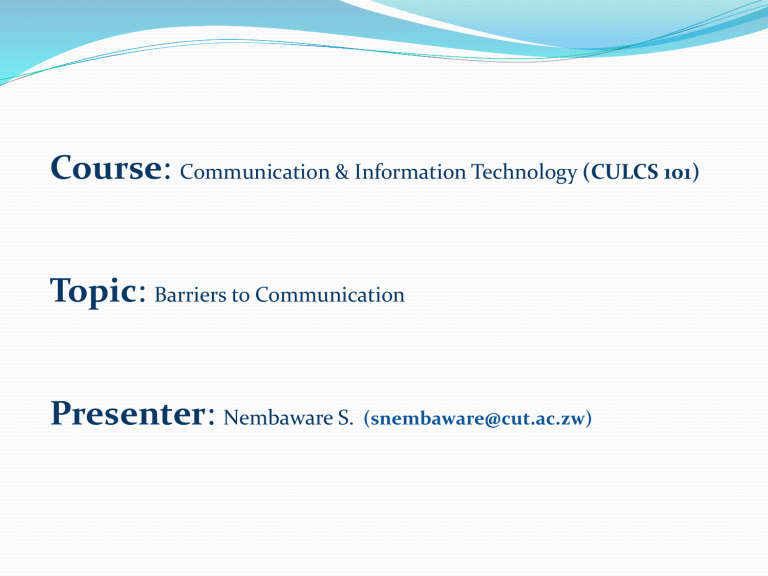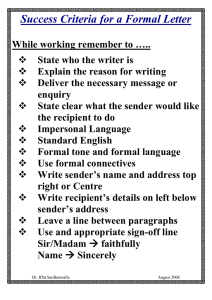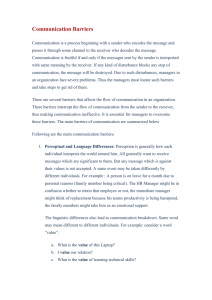
Course: Communication & Information Technology (CULCS 101) Topic: Barriers to Communication Presenter: Nembaware S. (snembaware@cut.ac.zw) BARRIERS TO COMMUNICATION Anything that interferes with the receiver’s receiving the message as the source intended the message to be received Interference/Disruption/Frustration/Hindr ance/Obstruction/Barricade/Hurdle/Noise Noise: Anything that distorts the message intended by the source Problems with any one of the components of the communication process can become a barrier to communication. Studying these barriers helps to establish opportunities for improving communication. • Those which are found within the sender and the recipient • Those which result from outside influences in the communication process Barriers caused by sender and recipient When thinking of these remember that they are only very rarely created deliberately by either party. Mostly, they are a result of incomplete understanding of the information, the situation, or the vocabulary and attitude of the other party. Distortion Occurs either at the encoding or decoding stage in the communication process. It occurs when language is put in a way that leads to incorrect or partial understanding of a message by the recipient. The message to be sent out needs to be clear. Contrast these two messages: "Please be here about 7:00 tomorrow morning." "Please be here at 7:00 tomorrow morning." The one word difference makes the first message muddled and the second message clear. The problem may be semantics, e.g., note this muddled newspaper ad: "Dog for sale. Will eat anything. Especially likes children. Call 888-3599 for more information." Internal barriers are fatigue, poor listening skills, attitude toward the sender or the information, lack of interest in the message, fear, mistrust, past experiences, negative attitude, problems at home, lack of common experiences, and emotions External barriers include noise, distractions, email not working, bad phone connections, time of day, sender using too many technical words for the audience, and environment Language Perceptual errors Stereotypes Ethnocentrism Pain discomfort Jargon Culture Defence mechanism Nature of the environment Sounds related physical disturbance – affecting audience attention Mannerisms – playing with key bunch, tapping on the desk Air vibration, people talking Eg: Poor outdated equipment May result from the receiver’s physical state An individual’s personal discomfort eg. Poor health, poor eyesight or hearing difficulties Eg: a listener with hearing challenges in a noisy place oMental turbulence of any kind – affects attention oBiases, prejudices – in both sender and receiverclosed mindedness oPre-occupation, ego hang-ups, fatigue, anxiety, disinterest, cultural disparities oSelf-centred attitude, defensiveness, resistance to change Semantics is the systematic study of meaning At times problems arise in expression and transmission of meaning DeVito: interference is due to the receiver failing to grasp the meanings intended by the sender – eg: jargon, technical or complex terms When people do not speak the same language or when they have different levels of proficiency in a language However, barriers can also exist even when people speak the same language Inappropriate register (slang, colloquial, formal, informal, professional, jargon) Lack of sensitivity to the receiver Lack of basic communication skills Insufficient knowledge of the subject Information overload Emotional interference oA bad cell-phone line oAn e-mail or letter not formatted properly oChannel barrier – if a sender chooses an inappropriate channel of communication oLong communication chain - confusion •Lack of interest •Lack of knowledge •Emotional distractions •Physical distractions No provision for feedback Inadequate feedback List of commonplace Barriers Information overload – messages that are so packed with information that they are difficult to interpret and process Messages in which the information is so thin that the recipient becomes bored or frustrated Negative timing in communicating the message can prevent its conveyance. For example, experts obsessed with the urgency of particular development issues may want to pressurize the people into adopting the ideas rather too fast. The chances of resistance are high. Language Barrier (at 2 levels) – poor choice of language register – using technical language/jargon/terminology that is not in the receiver’s field – semantic distortion or poorly expressed messages – also the wrong diction/choice of words eg. use of a patronizing tone – peremptory and dictatorial orders Cont...... Differing status - Power differences – these can be a barrier to communication. If the people at the top disseminate ideas without going through community leaders, who are themselves already knowledgeable, it is most likely they will use their influence to discourage people from accepting change. Different cultural backgrounds – differences in approaching the subject of immediacy – varying perceptions on pertinent/topical concerns – receivers believing that the ideas being conveyed are inferior to theirs – a message being communicated may not have an immediate appeal to recipients of a certain cultural orientation Non-verbal behavior - Irritating mannerisms that stop people from listening Lack of trust as well as lack of interest on the part of the receiver Cont....... Inadequate communication structures Incorrect choice of medium or channel Poor planning of information Organizational structure – size of organization - closed communication climate Unethical communication Physical distractions Cont....... Failure to analyze the needs of the receiver Poor listening and lack of attention to feedback Assuming that the receivers know more than they really do Insensitive behavior on the part of senders and receivers Too many people to pass on the message from the sender to the receiver Poor feedback, as well as omissions and errors as messages are passed on Cont....... Insensitive or poor choice of language by sender or receiver Insufficient information and lack of clarity Poor encoding or decoding skills – filling in of imagined gaps – unjustified simplification Wrong emphasis in information – failure by the receiver to make out a message’s most important parts Overcoming the barriers Many of the most important barriers to communicating may be overcome by following a few simple rules: Appreciate context adequately – set up, age group, gender, culture Use appropriate register – context specific jargon Deal with distractions – eg. Turn of source of noise, avoid disruptive multi-tasking Use corroboration to supplement encoding process – eg. Use off gestures, facial expression, tonal variation etc Solicit feedback from audience Develop personal communication skills This is one of the simplest ways in which communication may be improved. Communication skills cover the ability to: write clear language so that meaning is expressed directly and without ambiguity talk to a wide range of people in formal and informal settings read for the correct understanding of information listen and understand Active listeners: Listen politely Ask questions politely Acknowledges speaker’s point of view Does not change or add anything to what has been said Know when to communicate Judging the right moment to make communication is important. a Choosing the right moment can help. E.g. Tackling your employer in the corridor when you want to ask him a favour is probably not a good idea. Choosing the right moment, both in terms of psychological rightness and good timing, is thus a very important way of avoiding barriers of attitude in the recipient. Know with whom to communicate Communication with the wrong person can create all sorts of misunderstandings. In business, communicating with the wrong person will give the impression of inefficiency, which would not be good for future communications. Choose the medium carefully Always think carefully about the best kind of communication medium for a particular situation and recipient. e.g. in business, written communication is essential but in some cases it would be too formal and restricting. Match the expression to the recipient The most important rule for communicating. Distortion may occur at encoding when sufficient care is not taken over the vocabulary and background of the recipient by the sender. Consideration must also be given of your relationship with the recipient. Conclusion These rules will not guarantee communication on every occasion. perfect There will be times when internal ‘distortion’ and external ‘noise’ will still erect barriers. However, striving to follow these rules on all occasions makes communication far more effective as you learn to consider the other person’s point of view and assess the real purpose of what you are trying to achieve. Thank you……







